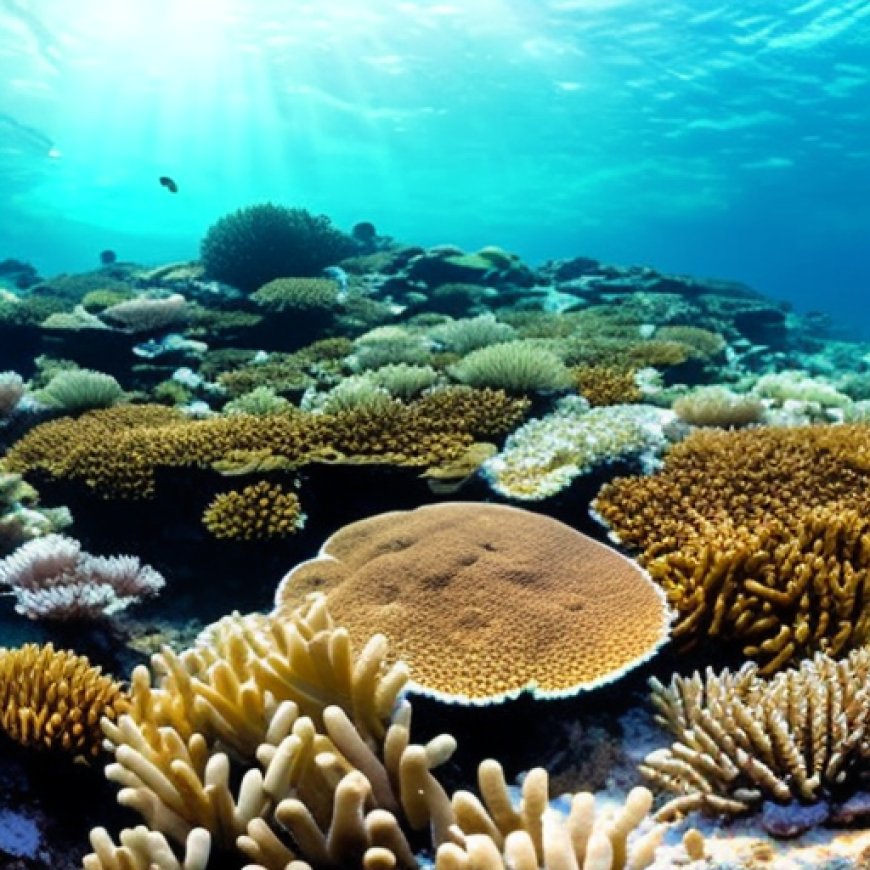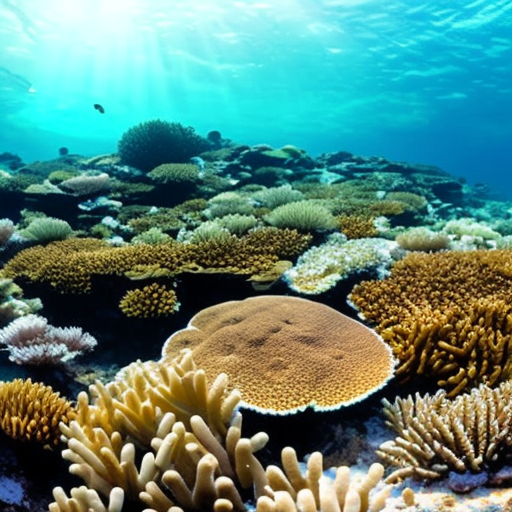The world’s coral reefs are facing another mass bleaching event — maybe the biggest ever | CBC News
The world's coral reefs are facing another mass bleaching event — maybe the biggest ever CBC News


The World’s Oceans Experience Global Mass Coral Bleaching Event
The world’s oceans are experiencing another global mass coral bleaching event because of unprecedented heat, scientists at the U.S. National Oceanic and Atmospheric Administration confirmed.
“This is the fourth time, on record, that coral bleaching has occurred simultaneously within all major ocean basins,” said Derek Manzello, ecologist and co-ordinator of NOAA’s Coral Reef Watch.
Bleaching — a ghostly discolouration, in stark contrast to vibrant colours found in reefs — can occur when corals are heat-stressed, expelling microscopic algae from within. The longer and hotter it gets, the more likely the corals will die, disrupting fragile ecosystems as well as the lives and livelihoods of people who depend on them.
But the full extent of damage is yet to come. Manzello is seeing an increase in affected reefs every week.
“If that trend continues, this will be the most spatially expansive, global bleaching event on record — in as little as a few weeks, potentially,” Manzello warned.
No Ocean Spared
Global sea surface temperatures have reached new heights in the last year, driven in part by oceans absorbing the excess atmospheric carbon from greenhouse gas emissions.
NOAA has confirmed mass bleaching in reefs throughout the world, from Panama to the Persian Gulf to the South Pacific. Manzello says just over half of the world’s reefs were affected by the current event, but it was near total in the Atlantic — a record-setting 98.5 per cent of the coral zones there experienced bleaching-level heat.
Just last week, the Australian Marine Conservation Society raised the alarm about bleaching in the southern Great Barrier Reef, where the last global bleaching event ended up killing a third of all corals.
Coral Reef Watch’s satellite data shows that hotspots are being seen in every ocean, with Atlantic, Pacific and Indian ocean corals experiencing a range of moderate to extreme heat stress. The unprecedented ocean temperatures even forced a revision of this alert system last year — adding Levels 3 to 5, the last of which represents “risk of near complete mortality.”
Stressed Out
Rohan Arthur, a marine biologist who has extensively studied the reefs in Lakshadweep off India’s southwest coast, expected this declaration.
But as he put it, darkly, “with all the enthusiasm of an undertaker measuring a corpse.”
Arthur, who is with the Nature Conservation Foundation based in Mysuru, India, has been tracking sea surface temperatures in Lakshadweep over the last year and has seen an unprecedented 1 C rise above average. The corals are starting to show it, too.
“A mass bleaching event itself is a morbidly beautiful sight,” Arthur wrote to CBC News via email, “with the reef turning every shade of pink and blue and white on its way to a surreal death.”
Having spent more than 25 years looking at those reefs, including past bleaching events, Arthur feels the impending devastation in the pit of his stomach. It’s a connection echoed an ocean away by Nicola Smith, assistant professor of biology at Concordia University in Montreal.
“It hits me personally when I think about these damages,” said Smith, who was born and raised in the Bahamas. When these marine heat waves hit, there’s little escape.
“It feels like you’re swimming in a cup of tea,” Smith said. Marine organisms are “sitting in these elevated temperatures for very long periods of time, becoming physiologically stressed.”
Food, Shelter, and Shield
Because they are both organism and habitat — to an estimated 25 per cent of the world’s marine life — experts say corals are critical for communities around them.
“When a coral reef dies, the coral fishes will leave the habitat because they cannot survive there,” Li explained. She points to the central Pacific nation of Kiribati, where fishers depend on reef fish populations for their livelihoods.
Smith says recreational tourism suffered as well as food security — including having access to affordable sources of protein found within reef fish. Furthermore, as climate change heats up the ocean and degrades these reefs, a line of defense is lost.
“Corals are a natural sea wall,” said Smith, describing them as a “kind of barrier to the big waves that would come with intense storms” that climate change is supercharging.
Is Relief Coming?
Another contributor to mass bleaching is the naturally occurring phenomenon El Niño, which was also present during the last three events in 1998, 2010 and 2014-2017. Characterized by warming waters in the Pacific, it can also drive up global temperatures and affect weather patterns, too.
The potential good news is that the current El Niño is waning, with NOAA’s Climate Prediction Center expecting a period of neutrality between April and June — with the cooler La Niña pattern “potentially developing during late summer 2024.”
The wrinkle, however, is that both of these climate patterns — known as the El Niño-Southern Oscillation — have been getting warmer. Manzello points out that localized coral bleaching events have also happened during the normally cool La Niña years. Still, he hopes it can provide some relief for parts of the Pacific, where the situation is dire.
“La Niña can’t come soon enough,” Manzello said.
But Smith warns that given the Intergovernmental Panel on Climate Change’s estimation that future warming of 2 C could lead to the loss of 99 per cent of the world’s coral, hoping for a cooler period is short-term thinking compared to doing more to lower our emissions to keep warming in check.
“It’s kind of frustrating, because our lack of action on climate change is literally going to lead to mass extinction.”
SDGs, Targets, and Indicators
-
SDG 14: Life Below Water
- Target 14.2: By 2020, sustainably manage and protect marine and coastal ecosystems to avoid significant adverse impacts, including by strengthening their resilience, and take action for their restoration in order to achieve healthy and productive oceans.
- Indicator 14.2.1: Proportion of national exclusive economic zones managed using ecosystem-based approaches.
- Indicator 14.2.2: Progress by countries in the degree of implementation of international instruments aiming to combat illegal, unreported and unregulated fishing.
-
SDG 13: Climate Action
- Target 13.3: Improve education, awareness-raising and human and institutional capacity on climate change mitigation, adaptation, impact reduction and early warning.
- Indicator 13.3.1: Number of countries that have integrated mitigation, adaptation, impact reduction and early warning into primary, secondary and tertiary curricula.
-
SDG 15: Life on Land
- Target 15.1: By 2020, ensure the conservation, restoration and sustainable use of terrestrial and inland freshwater ecosystems and their services, in particular forests, wetlands, mountains and drylands, in line with obligations under international agreements.
- Indicator 15.1.1: Forest area as a proportion of total land area.
- Indicator 15.1.2: Proportion of important sites for terrestrial and freshwater biodiversity that are covered by protected areas, by ecosystem type.
Table: SDGs, Targets, and Indicators
| SDGs | Targets | Indicators |
|---|---|---|
| SDG 14: Life Below Water | Target 14.2: By 2020, sustainably manage and protect marine and coastal ecosystems to avoid significant adverse impacts, including by strengthening their resilience, and take action for their restoration in order to achieve healthy and productive oceans. | Indicator 14.2.1: Proportion of national exclusive economic zones managed using ecosystem-based approaches. Indicator 14.2.2: Progress by countries in the degree of implementation of international instruments aiming to combat illegal, unreported and unregulated fishing. |
| SDG 13: Climate Action | Target 13.3: Improve education, awareness-raising and human and institutional capacity on climate change mitigation, adaptation, impact reduction and early warning. | Indicator 13.3.1: Number of countries that have integrated mitigation, adaptation, impact reduction and early warning into primary, secondary and tertiary curricula. |
| SDG 15: Life on Land | Target 15.1: By 2020, ensure the conservation, restoration and sustainable use of terrestrial and inland freshwater ecosystems and their services, in particular forests, wetlands, mountains and drylands, in line with obligations under international agreements. | Indicator 15.1.1: Forest area as a proportion of total land area. Indicator 15.1.2: Proportion of important sites for terrestrial and freshwater biodiversity that are covered by protected areas, by ecosystem type. |
Analysis
-
Which SDGs are addressed or connected to the issues highlighted in the article?
The issues highlighted in the article are connected to SDG 14: Life Below Water, SDG 13: Climate Action, and SDG 15: Life on Land.
-
What specific targets under those SDGs can be identified based on the article’s content?
- Under SDG 14: Life Below Water, the specific target identified is Target 14.2: By 2020, sustainably manage and protect marine and coastal ecosystems to avoid significant adverse impacts, including by strengthening their resilience, and take action for their restoration in order to achieve healthy and productive oceans.
- Under SDG 13: Climate Action, the specific target identified is Target 13.3: Improve education, awareness-raising and human and institutional capacity on climate change mitigation, adaptation, impact reduction and early warning.
- Under SDG 15: Life on Land, the specific target identified is Target 15.1: By 2020, ensure the conservation, restoration and sustainable use of terrestrial and inland freshwater ecosystems and their services, in particular forests, wetlands, mountains and drylands, in line with obligations under international agreements.
-
Are there any indicators mentioned or implied in the article that can be used to measure progress towards the identified targets?
- For Target 14.2 under SDG 14: Life Below Water, the article mentions Indicator 14.2.1: Proportion of national exclusive economic zones managed using ecosystem-based approaches and Indicator 14.2.2: Progress by countries in the degree of implementation of international instruments aiming to combat illegal, unreported and unregulated fishing.
- For Target 13.3 under SDG 13: Climate Action, the article mentions Indicator 13.3.1: Number of countries that have integrated mitigation, adaptation, impact reduction and early warning into primary, secondary and tertiary curricula.
- For Target 15.1 under SDG 15: Life on Land, the article mentions Indicator 15.1.1: Forest area as a proportion of total land area and Indicator 15.1.2: Proportion of important sites for terrestrial and freshwater biodiversity that are covered by protected areas, by ecosystem type.
Behold! This splendid article springs forth from the wellspring of knowledge, shaped by a wondrous proprietary AI technology that delved into a vast ocean of data, illuminating the path towards the Sustainable Development Goals. Remember that all rights are reserved by SDG Investors LLC, empowering us to champion progress together.
Source: cbc.ca

Join us, as fellow seekers of change, on a transformative journey at https://sdgtalks.ai/welcome, where you can become a member and actively contribute to shaping a brighter future.







